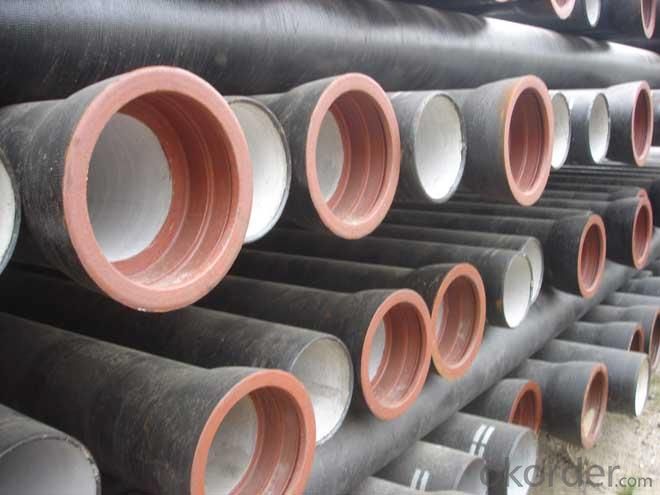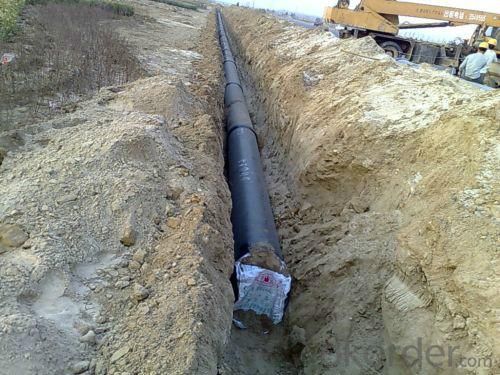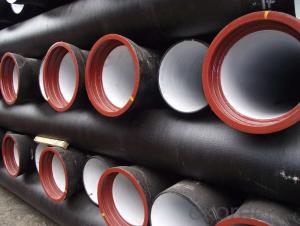Ductile Iron Pipe C40 DN300-DN900 ISO2531 for Water Supply
- Loading Port:
- China main port
- Payment Terms:
- TT or LC
- Min Order Qty:
- 20 m.t.
- Supply Capability:
- 200000 m.t./month
OKorder Service Pledge
OKorder Financial Service
You Might Also Like
1,Ductile Iron Pipe Description :
Ductile Iron pipe are manufactured according to ISO 2531 or BS EN545 or BS4772 FOR POTABLE WATER ,internal is cement lining or wet epoxy coating;External is zinc plus bitumen or wet epoxy coating. We also manufacture ductile iron fittings with fusion bonded epoxy both inside and outside. All the producets are sutible to water pipes fields.
1) Pipes confirm to ISO2531,K9 class,T type joint,6m long,with inside cements lining conform to ISO4179, outside Zinc spraying(130g/m2) and bitumen coating(70μm) conform to ISO8179.
2) Pipe ends: Spigot and socket ends, with 100% SBR rubber gaskets
accoding to ISO4633
3) we can do third party inspection according to customer's request.
4) Our products have been sold to many international market,
such as Middle East and South East Asia and Africa.
2,Main Features of the Ductile Iron Pipe:
·High yield strength
·High tensile Strength
·High corrosion resistance
·Pressure Resistence
·Anti-corrosion
·Installation is convenient
·Satisfy the highest hygienic standards
. Internal Lining: Cement, conform to ISO4179
. External coating: Zinc + Bitumen, conform to ISO8179
. Rubber: NBR, SBR, EPDM according to ISO4633 / EN681.1
. Note: The gaskets, bolts & nuts are supplied respectively as your special requirement
3,Ductile Iron Pipe Images:


4. Ductile Iron Pipe Specification
Surface Finishes:Bare, Oiled, Mill Varnish, Galv,FBE, FBE Dual, 3LPE, 3LPP, Coal Tar,Concrete Coating and Tape Wrap
End Finishes: Beveled, Square Cut, Threaded, hat
Additional Services: Internal Coating
Packaging: packed in bag, plastic bag, steel strip, steel wire,double wire, iron box, wooden box,
tarpaulin, plastic sheeting
Test :X-ray, UT, magnetic particle,inspection,hydrostatic test.
Processing service :Beveling, Threading, Slotting, Cut-to length, Bends, Quench and Temper, Fabrication, Double-jointing and On-site assistance
Documentary MTC: material certification,Origin certification, CI or PI,Test Report, export licence, handling order, B/L,insurance policy,shipping instructions, contract, packing list etc.
5.FAQ:
We have organized several common questions for our clients,may help you sincerely:
1.Q: Why would you choose ductile iron pipe rather than other pipe materials?
A:The reasons are obvious for that not only ductile iron pipe possesses the inherent strength and flexibility of ductile iron, combined with proven corrosion protection systems, but also the cost savings can be achieved from design to installation and commissioning.
2.Q:Why can you guarantee the inner of pipes can’t be corroded?
A: High alumina cement mortar lining and sulphate-resistant cement mortar lining. These two special linings are applicable to inner anti-corrosion for sewage pipes, improving resistance to erosion of the sewage components.
- Q:How are ductile iron pipes protected against external impact or loading?
- Ductile iron pipes are protected against external impact or loading through various methods. One common method is to apply a protective coating or wrapping on the pipes, which helps to prevent corrosion and reduces the risk of damage from external forces. Additionally, the pipes are often designed with a thicker wall thickness to enhance their strength and resistance to external impact. Furthermore, the installation of appropriate bedding and backfill materials around the pipes provides additional support and protection against external loading. Regular inspections and maintenance practices also play a crucial role in ensuring the long-term durability and protection of ductile iron pipes.
- Q:How are ductile iron pipes installed?
- Ductile iron pipes are typically installed using a variety of methods, including trenching or open-cut excavation, horizontal directional drilling, and pipe bursting. In the traditional trenching method, a trench is dug to the required depth and slope, and the pipe is then lowered into place and joined using mechanical or push-on joints. Horizontal directional drilling involves drilling a pilot hole and then pulling the pipe through it, while pipe bursting involves breaking the existing pipe and replacing it with a new ductile iron pipe.
- Q:How do ductile iron pipes handle differential settlement?
- Ductile iron pipes are known for their exceptional durability and ability to withstand various environmental conditions, including differential settlement. Differential settlement refers to the uneven settling of the ground, which can often lead to stress and strain on underground pipes. Ductile iron pipes are specifically designed to handle such settlement issues due to their inherent flexibility and strength. These pipes have the ability to flex and accommodate slight ground movements without causing significant damage or failure. The flexibility of ductile iron pipes allows them to distribute the stress and strain caused by differential settlement more uniformly along their length. This feature helps prevent concentrated stress points that could potentially lead to cracks or fractures in the pipe. Additionally, the inherent strength of ductile iron pipes provides them with the necessary resistance to withstand the forces generated by differential settlement. The pipes' robust construction and high tensile strength make them less susceptible to deformation or damage caused by ground movements. Furthermore, ductile iron pipes are commonly installed with flexible joints, such as rubber gaskets or push-on joints. These joints allow for some movement and accommodate any slight misalignment or settlement that may occur. By providing flexibility at the joints, the pipes can better adapt to changes in ground conditions and reduce the risk of failure. In summary, ductile iron pipes are well-equipped to handle differential settlement due to their flexibility, strength, and the use of flexible joints. These features ensure that the pipes can withstand ground movements and continue to function effectively without compromising their integrity or longevity.
- Q:When the ductile iron pipe is pressed, the three links are always running out. What should be done?
- This situation depends on whether the pipeline installation is in place and the apron installation is standard. If there are no other problems, it is recommended to play a cement pier, half a pack of three can be solved.
- Q:Can ductile iron pipes be used for water treatment facilities?
- Yes, ductile iron pipes can be used for water treatment facilities. Ductile iron pipes are known for their strength, durability, and corrosion resistance, making them suitable for transporting water in various treatment processes such as filtration, disinfection, and distribution. Their ability to withstand high pressures and external loads makes them a reliable choice for water treatment facilities.
- Q:Nodular cast iron, heat treatment process and so on
- High temperature graphitization annealing was adopted to eliminate the chill, and 900-950 and 2-4H obtained ferrite structure
- Q:What are the different types of linings available for ductile iron pipe?
- Ductile iron pipes offer various linings with distinct advantages and applications. 1. Cement mortar lining: The most commonly used lining for ductile iron pipes is cement mortar. It involves applying a layer of cement mortar to the pipe's interior surface. This lining excels in resisting corrosion and chemical attacks, making it suitable for potable water distribution, wastewater conveyance, and industrial pipelines. Additionally, it improves flow efficiency by reducing friction and turbulence within the pipe. 2. Polyethylene lining: Ductile iron pipes often utilize polyethylene linings when corrosion resistance is a primary concern. This lining consists of a layer of high-density polyethylene (HDPE), either extruded or sprayed onto the inner surface of the pipe. Polyethylene lining provides exceptional resistance to corrosion, abrasion, and chemical attacks, making it ideal for transporting aggressive fluids such as saltwater, chemicals, or industrial waste. 3. Polyurethane lining: For applications requiring protection against abrasive wear, polyurethane linings are commonly employed in ductile iron pipes. This lining is created by spraying or pouring a layer of polyurethane onto the inner surface of the pipe. Polyurethane lining offers excellent resistance to abrasion, impact, and chemical attacks. It is suitable for conveying abrasive slurries, mining applications, and other high-wear environments. 4. Epoxy lining: To safeguard against corrosion and chemical attacks, epoxy linings are applied to ductile iron pipes. This lining is typically formed by applying a layer of epoxy resin to the pipe's inner surface using centrifugal casting or electrostatic spraying. Epoxy lining demonstrates outstanding adhesion and corrosion resistance, making it suitable for various applications like potable water distribution, wastewater treatment, and industrial pipelines. 5. Zinc lining: Ductile iron pipes employ zinc linings to provide cathodic protection against corrosion. This lining involves applying a layer of zinc to the pipe's inner surface through hot-dip galvanizing or electroplating. Zinc lining acts as a sacrificial anode, corroding preferentially to the iron pipe and shielding it from corrosion. It is commonly used in highly corrosive environments like seawater or acidic soils. Ultimately, the selection of a lining for ductile iron pipes relies on the specific requirements of the application, including the transported fluid, desired corrosion resistance, and potential for abrasive wear. Seeking guidance from industry experts and considering factors like cost, longevity, and maintenance requirements aids in determining the most suitable lining option for a particular project.
- Q:How does ductile iron pipe perform in areas with high soil corrosivity?
- Ductile iron pipe performs well in areas with high soil corrosivity due to its inherent corrosion resistance. The unique composition of ductile iron, with its graphite nodules providing internal protection, makes it highly resistant to corrosion from soil and external factors. This allows the pipe to maintain its structural integrity and longevity in corrosive environments, making it a reliable choice for such areas.
- Q:Are there any special considerations for installing ductile iron pipe in rocky soils?
- Yes, there are special considerations for installing ductile iron pipe in rocky soils. The presence of rocks can pose challenges during the installation process as they can cause damage to the pipe or impede its proper alignment. Therefore, it is important to carefully assess the soil conditions and rock content at the installation site. Additional measures such as proper bedding and backfilling techniques, using protective coatings or linings, and employing specialized equipment may be necessary to ensure the durability and longevity of the ductile iron pipe in rocky soils.
- Q:Can ductile iron pipes be used for both water and sewage systems?
- Ductile iron pipes can serve for both water and sewage systems, owing to their remarkable strength and durability. Renowned for their exceptional mechanical properties, these pipes can endure the immense pressure and stress encountered in such systems. Furthermore, their resistance to corrosion renders them optimal for transporting both clean water and sewage. Consequently, ductile iron pipes emerge as a dependable and adaptable option for water and sewage systems, given their wide-ranging applications.
1. Manufacturer Overview |
|
|---|---|
| Location | |
| Year Established | |
| Annual Output Value | |
| Main Markets | |
| Company Certifications | |
2. Manufacturer Certificates |
|
|---|---|
| a) Certification Name | |
| Range | |
| Reference | |
| Validity Period | |
3. Manufacturer Capability |
|
|---|---|
| a)Trade Capacity | |
| Nearest Port | |
| Export Percentage | |
| No.of Employees in Trade Department | |
| Language Spoken: | |
| b)Factory Information | |
| Factory Size: | |
| No. of Production Lines | |
| Contract Manufacturing | |
| Product Price Range | |
Send your message to us
Ductile Iron Pipe C40 DN300-DN900 ISO2531 for Water Supply
- Loading Port:
- China main port
- Payment Terms:
- TT or LC
- Min Order Qty:
- 20 m.t.
- Supply Capability:
- 200000 m.t./month
OKorder Service Pledge
OKorder Financial Service
Similar products
New products
Hot products
Hot Searches
Related keywords


























